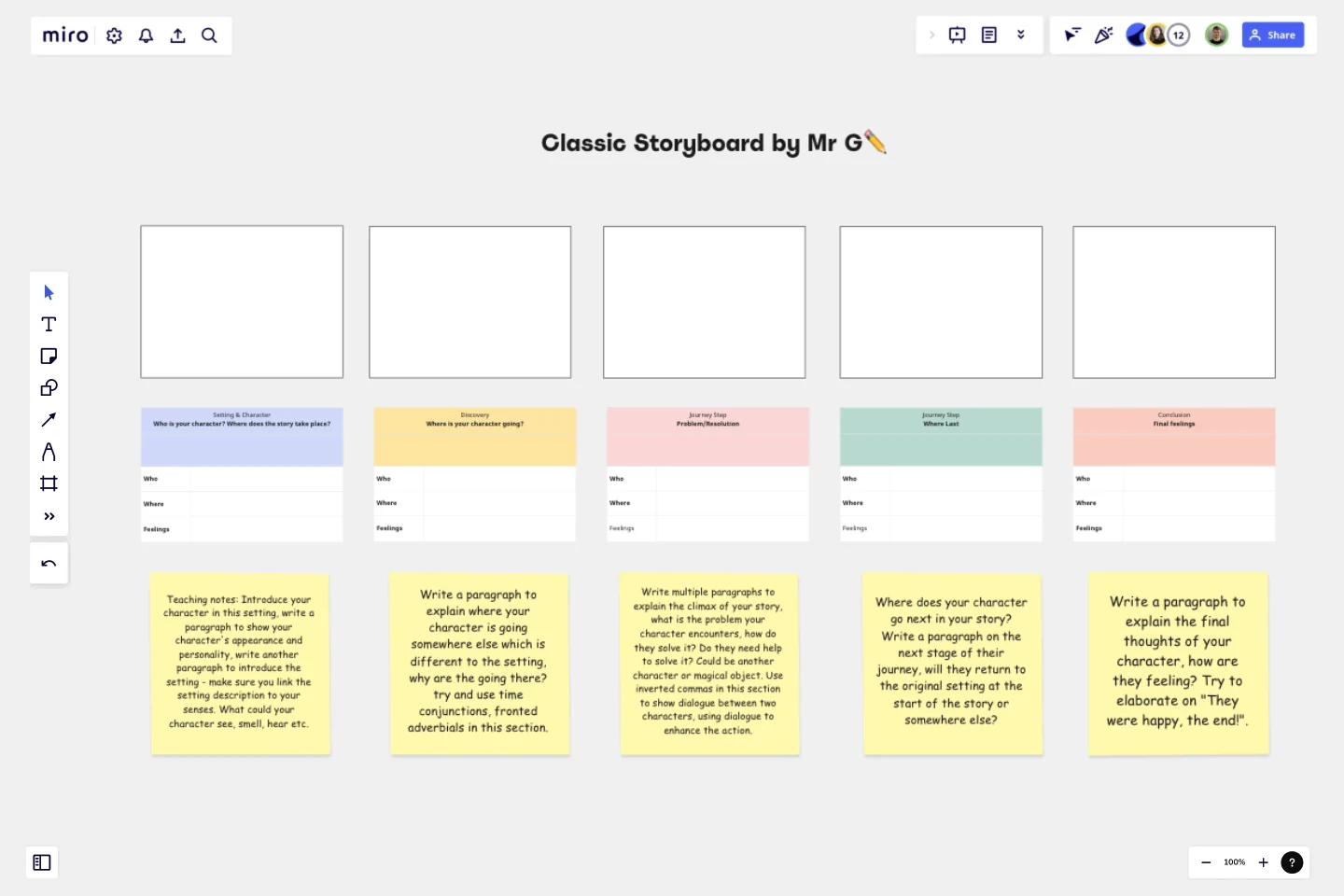Fiction Storyboard
Storyboard template for teachers.
This is a storyboard used to structure fictional writing in KS2 in England (7-11 year olds). It breaks down the skills required for story writing with sticky notes provided for key teaching points, it follows the story writing style designed by Alan Peat. This can be displayed on IWB and used as a whole class teaching tool.
Story writing lesson plan
Below is a brief overview for planning a lesson around this storyboard framework:
Build your character (Who?): Start by introducing your character and the story's setting. Write a paragraph to describe your character's appearance and personality. Write another paragraph to describe the setting by using your five senses. What can your character see, hear, smell, feel, or taste?
Describe the setting (Where?): What does your character want, or where are they going based on their motivations? Use time conjunctions and fronted adverbials in this section.
Describe where they go next (Where to?): Where does your character go next in your story? Write a paragraph on the next stage of their journey, will they return to the original setting at the start of the story or somewhere else?
Explain the conflict (What's the problem?): Write two to three paragraphs to explain the climax of your story, what is the problem your character encounters, how do they solve it? Do they need help to solve it? Could be another character or magical object. Use inverted commas in this section to show dialogue between two characters, using dialogue to enhance the action.
Offer a solution (How is it fixed?): Next, write another paragraph to describe how your character's problem is fixed. Does anyone help them? If so, who? How do they feel during this process?
Describe the solution (How does it end?): Write a paragraph to explain the final thoughts of your character, how are they feeling? Try to more elaborate on "They were happy, the end!".
This template was created by Jamie Gilbert.
Get started with this template right now.
Research Template
Works best for:
Education, Desk Research, Product Management
Teams often need to document findings from usability testing sessions and customer interviews into a systematic, flexible user research template. Collecting everyone’s observations into a centralized location makes it easier to share insights company-wide and suggest new features based on user needs. Research templates can be used to record quantitative or qualitative data.. When it’s your job to ask questions, take notes, learn more about your user, and test iteratively, a Research Template can help you validate your assumptions, find similarities across different users, and articulate their mental models, needs, and goals.
Storyboard for Game Design Template
Works best for:
Storyboard
The Storyboard for Game Design template is a structured tool for visualizing your game’s development from concept to execution. It includes sections for roles, storyboarding, scripting, and asset management, ensuring clarity, consistency, and alignment across the team. Ideal for game designers, this template streamlines planning, helps manage resources, and promotes a cohesive and engaging gaming experience.
Storyboards by maad labs
Works best for:
Storyboard, Planning, Design
Simplify your story creation process with Storyboards by maad labs. This template offers a user-friendly interface for mapping out your narrative projects, making it ideal for both beginners and seasoned professionals. It includes sections for scene descriptions, character notes, and dialogue, helping you to organize your ideas and present them clearly. Use this template to enhance your storytelling workflow and bring your creative visions to life with ease
Empathy Map by Voltage Control
Works best for:
Market Research, Research & Design
Empathy Map 1-2 captures detailed user insights by focusing on their thoughts, feelings, and behaviors. This template helps you create user-centered products by ensuring you understand and address the real needs of your users.
Proto Persona Template
Works best for:
Design
Business decisions frequently rely on the personal preferences and assumptions of internal employees. However, making decisions that prioritize the needs of the individuals being served is helpful. When personas are developed effectively, they provide guidance to you and your team, ensuring that the interests of these crucial stakeholders are considered when making significant decisions.
Customer Journey Map by Columbia Road
Works best for:
Customer Journey Map
The aim of the customer journey is to help you break down the customer's activities from both a front-end and back-end perspective.
